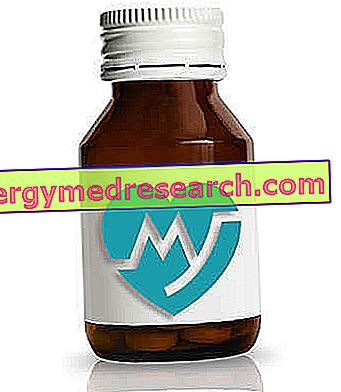Definition
Sepsis, otherwise known as septicemia, designates a clinical emergency in all respects, potentially fatal: we are talking about an alarming and exaggerated Systemic Inflammatory Response (SIRS), sustained by the body following a bacterial insult.
- Septicemia should not be confused with bacteremia: the latter condition is characterized by the mere presence of bacteria in the blood, in the absence of inflammation.
Causes
The cause that arises at the origins of sepsis is twofold: the insult of bacteria (eg Escherichia coli, Klebsiella spp. , Pseudomonas spp), viruses or fungi ( Candida spp.), And the Systemic Inflammatory Response (SIRS) of body. These two etiopathological elements, acting in synergy, cause an exaggerated damage.
Bacteria + SIRS → formation of micro-clots in blood vessels → ↑↑ cardiac contraction force → ↓ ↓ oxygen and nutrients in the various anatomical sites
Predisposing factors → abuse of cortisone, alcoholism, alteration of the immune system, cancer, infantile age / senescence, drug addiction, black race
Symptoms
- Mild phase: hypothermia (<35-36 ° C) or high fever (> 38.5 ° C), ca heart rate (> 90 bpm) and atoria respiratory rate (> 20 breaths per minute), known or presumed infection
- Severe sepsis: altered mental status, spots on the skin, difficulty breathing, cardiac dysfunction, ↓ ↓ diuresis, leukopenia, thrombocytopenia
- Septic shock: ↓↓ arterial pressure, ↑ † 'of serum concentration of reactive C protein and interleukin-6, gangrene, uncontrolled and widespread swelling of the whole body, thrombus in blood vessels, loss of organ function, death
Information on Sepsis - Drugs for Sepsis Treatment (Septicemia) is not intended to replace the direct relationship between health professional and patient. Always consult your doctor and / or specialist before taking Sepsis - Drugs for Sepsis Treatment (Septicemia).
drugs
Given the seriousness of the condition, it is understandable how the immediate intervention of medical aid is conditioning in order to guarantee the recovery of the patient suffering from sepsis: in other words, it is recommended to notify the doctor from the very first signs, even if only suspected septicemia, since temporization in front of a similar condition can cost lives.
As can be guessed, the mild phase of sepsis is easier to cure, even with only the help of drugs; different discourse must be made for the severe septicemic form and for septic shock, in which hopes of a positive prognosis are rather scarce.
The middle phase of sepsis should be treated with specific antibiotic drugs, directed against the pathogen involved in the infection; Antibiotic therapy, usually administered intravenously, is usually accompanied by a rehydration treatment, in which the patient receives large amounts of liquid intravenously.
Patients arriving in the severe phase of septicemia require careful medical monitoring and hospitalization in the intensive care unit of the hospital; Septic shock is immediately treated with ventilation and intubation to facilitate the patient's respiratory movements, compromised by sepsis. Some patients are subjected to dialysis, useful in the context of renal failure. Clearly, even the severe phase and septic shock must also be treated with antibiotic drugs to remove the pathogen.
Some patients may take steroid drugs to lighten inflammation, vasopressor drugs (to increase blood pressure), insulin (to maintain normal blood sugar levels), painkillers and, when necessary, modulators of the immune system.
Some patients must undergo surgery to remove the source of infection (eg pus, as in the case of abscesses).
Antibiotics for the treatment of sepsis
- Ceftriaxone (eg Ceftriaxone, Pantoxon, Ragex, Deixim): the drug is a third-generation cephalosporin, used in therapy for the treatment of severe sepsis. The dosage suggests taking 2 grams, intravenously, once a day, for at least two weeks, depending on the nature and severity of the condition.
- Cefuroxime (eg. Cefoprim, Tilexim, Zoref, Zinnat): belongs to the second generation cephalosporin class. For sepsis, it is recommended to start therapy from the earliest symptoms, and possibly to associate an aminoglycoside drug. Take 1.5 g of drug intravenously, every 6-8 hours. Continue therapy for 2-3 weeks, in full compliance with the instructions given by the doctor.
- Ceftazidime (eg Etazim, Liotixil, Fribat): the antibiotic drug is a third-generation cephalosporin, also indicated for the treatment of sepsis. We recommend taking 2 grams, intravenously, every 8 hours for 14 days. For more information: consult a doctor.
- Cefotaxima (eg Cefotaxima, Aximad, Lirgosin): another third-generation cephalosporin, used in therapy for the treatment of sepsis at a dose of 2 grams IV, to be taken every 6-8 hours. Do not exceed the dose of 2 g ev every 4 hours. Continue the therapy for 14 days.
- Tobramycin (eg Tobi podhaler): the drug is an exponent of aminoglycosides, also used to treat patients with sepsis. Start the treatment with a dose of 2 mg / kg of drug, to be taken intravenously; proceed with 1.7 mg / kg every 8 hours or with 5-7 mg / kg every 24 hours. Continue with the dosage just described for 10-14 days, depending on the nature and severity of the condition.
- Vancomycin (eg Zengac, Levovanox, Maxivanil): the drug (glycopeptide class) is given at a dose of 15 mg / kg intravenously, twice a day, for 10-14 days, for the treatment of sepsis.
- Ampicillin (eg. Augmentin, Klavux) and gentamicin (eg Gentamicin, Ciclozinil, Genbrix, Gentalyn): combination of antibiotics (respectively: beta lactam antibiotic + aminoglycoside) widely used in therapy for the treatment of neonatal septicemia. For the dosage: consult a doctor.
Vasopressor drugs : by promoting vasoconstriction, vasopressor drugs increase blood pressure values. Let us briefly recall that arterial pressure in patients with septic shock is very low.
- Noradrenaline or Norepinephrine (eg Noradr Con FN): it is a catecholamine indicated to increase arterial pressure in the context of septic shock. In such circumstances, it is advisable to inject a dose of active ingredient of 2-4 mcg / min, until a systolic blood pressure value between 80 and 100 mmHg is reached. Maintenance therapy plans to take 1-12 mcg of drug per minute.
- Dopamine (eg Dopamine BIL, Dopamine SAL): for the control of arterial pressure in the context of septic shock, it is recommended to take 1-5 mcg / kg / min of drug, using the continuous intravenous infusion. In extreme situations, it is possible to increase the dose up to 50 mcg / kg / min.
- Adrenaline or epinephrine (eg Jext, Adrenal, Fastjekt): the drug is a powerful vasopressor (or vasoconstrictor), useful for preventing airway obstruction in cases of severe sepsis and anaphylactic shock. The drug is particularly indicated when refractory hypotension is observed in the patient. It is recommended to administer the drug intramuscularly at a dosage of 0.3-0.5 ml in the adult and 0.01 ml / kg (max. 0.3 mg) in the child, immediately after the manifestation of the typical symptoms of sepsis ; repeat the administration every 5-15 minutes, depending on the severity of the condition.
Other drugs used in therapy for the treatment of sepsis : indicated to report the values of mean arterial pressure at least to 60 mmHg
- Filgrastim (Filgrastim ratiopharm, Filgrastim Hexa, Tevagrastim): the drug is similar to the human protein "granulocyte colony stimulating factor", useful in case of sepsis associated with leukopenia (neutropenia) to stimulate the bone marrow to synthesize a greater number of white blood cells . The dose of 10 mcg / kg per day is recommended for the treatment of sepsis in infants.
- Drotrecogin alfa (eg. Xigris): the drug is a coagulation modifier used for the treatment of severe sepsis in adults; as we know, blood clots can obstruct the circulatory network, thus denying oxygen and nutrients to organs and tissues. The active ingredient is administered into a vein, by slow injection of 96 hours: indicatively, the dose suggests taking 24 mcg / kg / hour (via infusone pump).
Recombinant protein C therapy : important both to break up blood clots caused by sepsis and to reduce swelling in a short time. Furthermore, the administration of this drug improves the circulation of the microcirculation, due to the fibrinolytic and anti-aggregation properties.
- Protein C (eg Ceprotein): the drug is available in solution (powder + solvent to be mixed), to be injected intravenously at a rate of 0.2 ml / kg / min for children weighing less than 10 kilos, and at dose of 2 ml / min for adults. The dosage established according to the patient.
Steroid drugs for the treatment of sepsis:
- Hydrocortisone (eg Plenadren): it is recommended to take 200-300 mg of the drug a day, for a week. Consult your doctor.
- Fludrocortisone (eg Florinef): the indicative dose to increase the probability of survival in patients with sepsis is 50 mcg / day for 7 days. The administration of this drug, in addition to decreasing inflammation, is indicated to increase blood pressure, altered in the context of sepsis.
Notes : In light of recent scientific data, it appears that the intake of 30 mg / kg / day of Methylprednisolone or a treatment with over 300 mg / day of hydrocortisone does NOT increase the probability of survival in patients with sepsis or septic shock.
Other drugs used in therapy to alleviate secondary symptoms in the context of sepsis:
- digitalis in general: indicated to facilitate the heart to pump blood in the various districts. Ex. Digoxin
- painkillers: therapeutic aids indicated to relieve pain
- sedatives: used in therapies to calm the patient
- insulin: when glycemic levels are altered in patients with sepsis, it is recommended to administer insulin to restore glucose concentration in the blood
- heparin and other blood thinners: indicated for the prevention of thrombi in the context of sepsis



